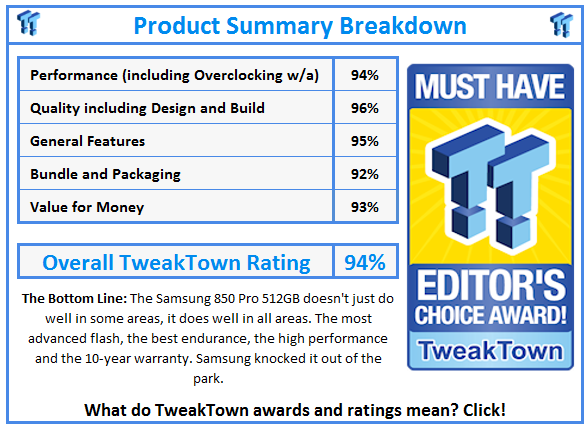Introduction & Specifications, Pricing and Availability
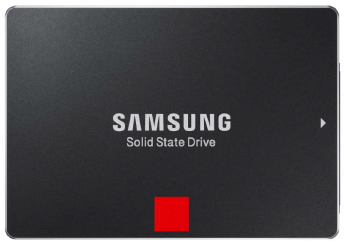
On paper, the Samsung 850 Pro 512GB should be the most exciting SSD for our normal audience. The 850 Pro drives we've already tested, the 128GB and massive 1TB, were both faster than competing products in their capacity sizes, and offer the longest warranty terms. When it comes to SATA III, we can't imagine a better SSD.
For the 850 Pro launch, we tested the two extremes of the capacity range, the smallest and the largest. The 850 Pro 128GB is a blistering fast small capacity SSD thanks to Samsung's new 3D V-NAND technology. The only problem is most gamers and enthusiasts require more than the capacity offered, 128GB. The massive 1TB 850 Pro is every enthusiast's dream, it just happens to cost $699.99 right now at Newegg, the same price as a decent notebook.
Dreams aside, the two most popular capacity sizes right now are 256GB and 512GB. That's what we're looking at this week. And today, we're kicking things off with the 850 Pro 512GB drive.
Specifications, Pricing and Availability
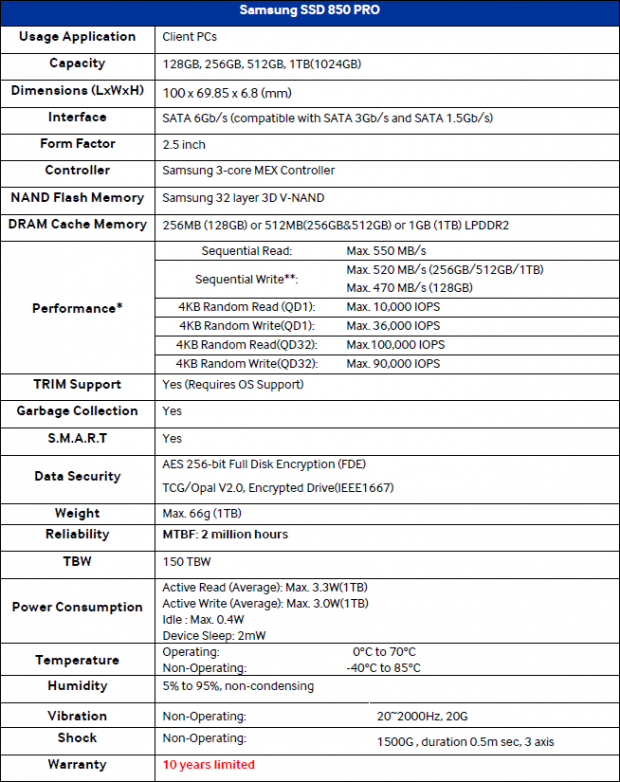
Samsung released four capacity sizes for the 850 Pro - 128GB, 256GB, 512GB and the 1TB. The buzz around the 850 Pro product line has centered on the performance, but this series has a lot more to offer users than just that. All four capacity sizes ship with a 10 year warranty that is covered for 150 TBW - even the small 128GB capacity size has the same TBW rating. Samsung won't go on record about how good the new 3xnm V-NAND flash is when it comes to endurance, but we've heard rumors of up to 35,000 PE cycles. To put that into perspective, we know there are some SSDs on the market shipping with 1,500 PE cycle flash and others rumored to have just 1,000 PE cycles. So, in comparison, the 850 Pro is head, elbows, waist, knees and toes above everything else shipping today, hence the long warranty.
The 850 Pro also ships with all of the latest check boxes filled in. On the security side, the drives use AES 256-bit full disk encryption and support both TCG Opal 2.0 and IEEE1667 (Microsoft eDrive).
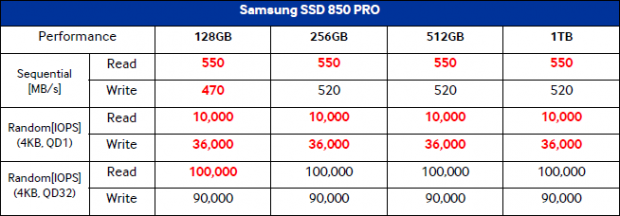
All four capacity sizes show a sequential read speed of 550 MB/s and a 4KB random read at queue depth 1 of 10,000 IOPS. It should be noted that Samsung is the only SSD manufacturer to deliver 10K IOPS at QD1 read. The 128GB model can write sequential data at 470 MB/s, while the three largest capacity sizes are capable of 520 MB/s. As you'll see later in this review, Samsung sandbagged on most of the claimed performance numbers - we managed to post higher performance numbers in nearly every category.

A quick scan at Newegg showed that all four capacity sizes are now available. The 128GB is the only model over $1 per GB. As you work your way up the capacity scale, the price per gigabyte decreases. The 512GB we're testing today still isn't cheap by today's mainstream SSD standards, but I'd say the $399.99 price point isn't out of line for what it offers.
The 850 Pro ships with a 10-year warranty and includes Samsung's Data Migration software for cloning you existing data to the new drive. Samsung's Magician software, now up to version 4.4 at the time of writing, also works with the 850 Pro. We'll take a look at the software later in this review.
Samsung 850 Pro 512GB SSD
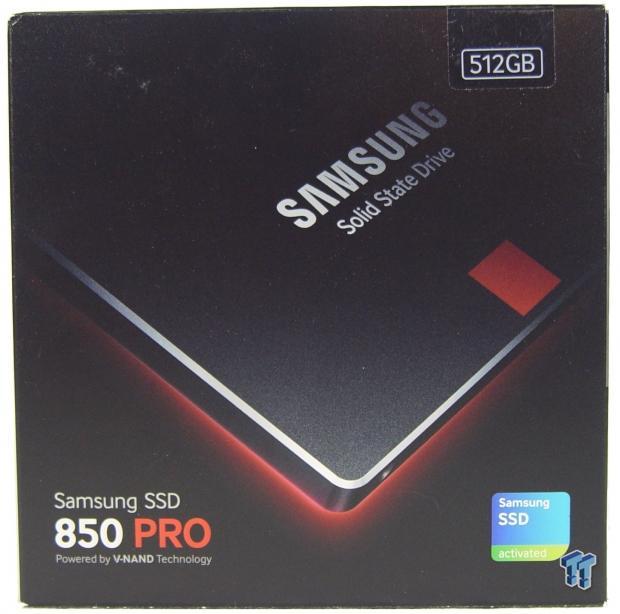
Samsung stepped away from the black and orange color scheme slightly with the 850 Pro. The black remains, but the orange is now closer to red than orange. The drive looks really good in a case with an ASUS ROG board.

This is the first time we received a full retail drive with the final production retail package. Not a lot has changed other than the warranty shows 10 year limited. On my last trip to Fry's in Silicon Valley, we found the 850 Pro drives on the shelf. We spent some time looking at the retail packages on all the SSDs at the brick and mortar store. A few of the drives listed performance numbers like the 850 Pro. Comparing the information on the packages, we think Samsung does a really good job showing the performance and features on the retail package.
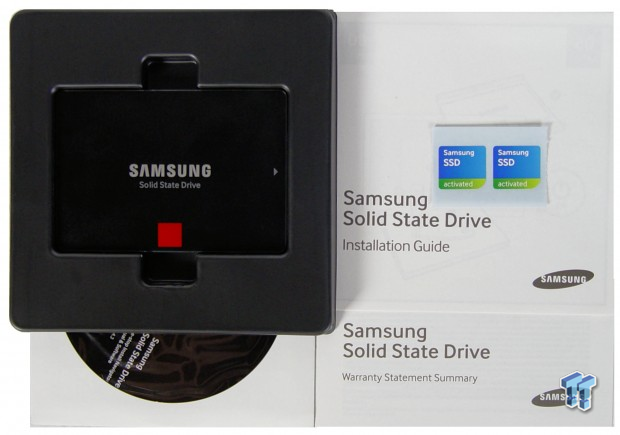
The retail package includes the SSD, two paper manuals, a pair of stickers, and a software disk with the software. You can also download the software via Samsung's website for the latest version.
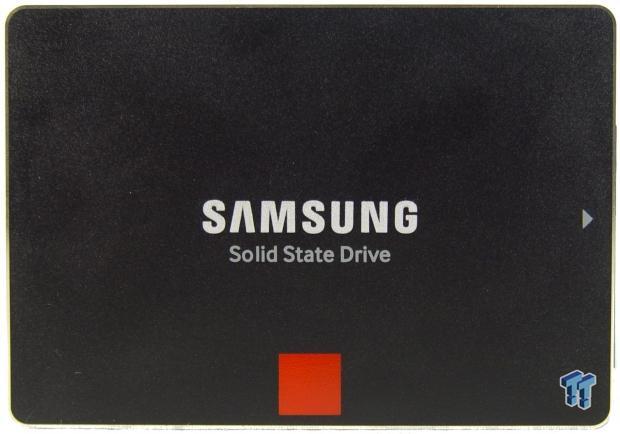
The drive is a 2.5" form factor with a 7mm z-height.
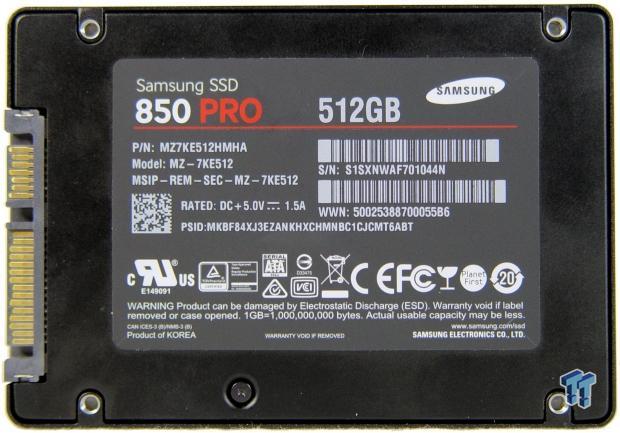
The label on the back shows the model and serial number. The case is made from machined aluminum.


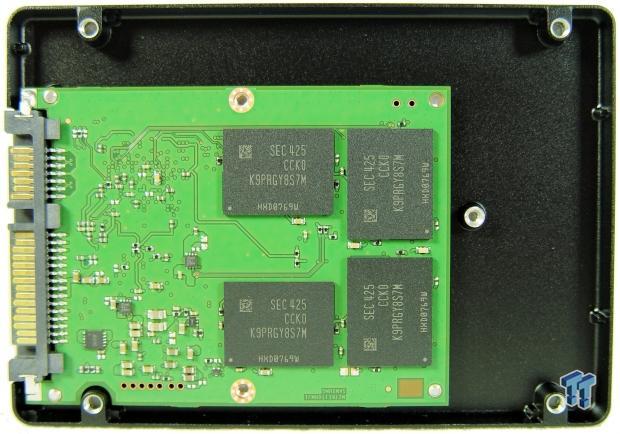
Inside the case we found a very small PCB that could be used in a 1.8" form factor should Samsung decide to build a smaller drive. Between the case and the PCB was a piece of thermal transfer material that was almost as large as the circuit board.

Samsung makes all of the components used on the 850 Pro, from the controller to the flash and the DRAM.

The 850 Pro uses the same MEX controller that Samsung used on the 840 EVO.

Buffering the page table data is low power DDR2 DRAM. The 512GB model uses 512GB of DRAM.

The 512GB 850 Pro uses eight V-NAND flash packages, four on each side of the PCB.
Samsung Software Package
Samsung Magician
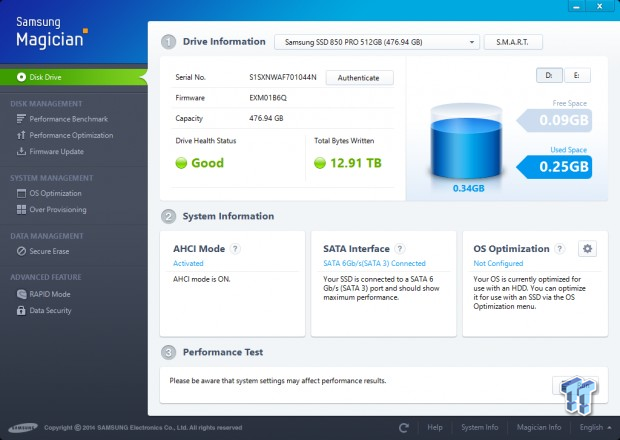
Samsung's Magician software is now up to version 4.4. The software is quite powerful and has a number of very nice features.
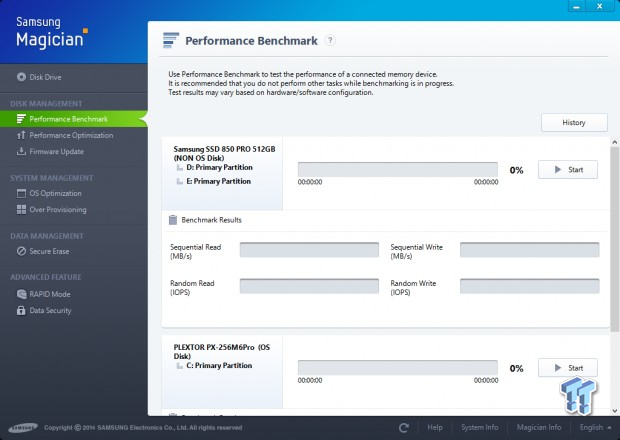





For the most part, all of the functions perform as expected, except for the Secure Erase feature. In Windows 7, we can SE the drive right in the Magician software in the operating system, but in Windows 8, we need to use a flash drive to boot without Windows to perform the operation.

The 850 Pro also supports RAPID Mode, a software defined cache layer that streamlines the random writes and sends them to the 850 Pro as sequential data. This increases overall performance and reduces the wear on the flash. RAPID Mode also increases the performance of the 850 Pro in most situations.




Samsung Data Migration

Samsung also has the Data Migration tool. The software is now up to version 2.7 and works really well so you can take your existing data from one drive and send it to the 850 Pro.


Test System Setup and ATTO Baseline Performance
Desktop Test System

Lenovo T440 - Notebook Power Testing with DEVSLP and Windows 8.1 Pro
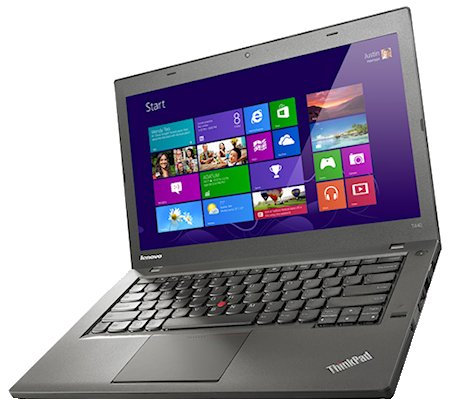
Nearly all of the performance tests run on the desktop system but we use a Lenovo T440 to run the power tests. The T440 is the latest addition to our client SSD test lab and allows us to test the notebook battery life offered by an SSD with advanced features like DEVSLP enabled.
ATTO - Baseline Performance
Version and / or Patch Used: 2.34

In our initial test with ATTO, we scored the Samsung 850 Pro 512GB at just over 563 MB/s sequential read and just over 534 MB/s sequential write speeds. These are a bit over the numbers on Samsung's specification sheet.
Benchmarks - Sequential Performance
HD Tune Pro - Sequential Performance
Version and / or Patch Used: 4.55

Given the large parallelism in high capacity sizes SSDs, it's easy for drives in this range to deliver performance at the limit of SATA III. The 850 Pro is no exception and the drive is capable of extremely high sequential read performance.

We see a lot more variation when writing data to the SATA drives, even with the large number of die in the larger capacity size drives. The Samsung 850 Pro shows here why it's one of the best performing drives on the market, delivering very high 64KB block writes.
HD Tach - Sequential Write Performance after Random Writes
Version and / or Patch Used: 3.0.4.0

After a number of sequential and random writes, we tested the 850 Pro 512GB with HD Tach. This software tests the sequential read and a write performance with 128KB data. The 850 Pro doesn't suffer from low write speeds after the random data tests.
Some of the lower quality drives on the market see strong dips in write performance, sometimes dropping write speeds down to as low as 10 MB/s. The 850 Pro made it through this test with little variation in both the read and write portions of the test.
Benchmarks - Anvil Storage Utilities
Anvil Storage Utilities
Version and / or Patch Used: RC6
So what is Anvil Storage Utilities? First of all, it's a storage benchmark for SSDs and HDDs where you can check and monitor your performance. The Standard Storage Benchmark performs a series of tests; you can run a full test or just the read or the write test, or you can run a single test, i.e. 4k QD16.
Anvil Storage Utilities is not officially available yet, but we've been playing with the beta for several months now. The author, Anvil on several international forums, has been updating the software steadily and is adding new features every couple of months.
We can use Anvil several different ways to show different aspects for each drive. We've chosen to use this software to show the performance of a drive with two different data sets. The first is with compressible data and the second data set is incompressible data. Several users have requested this data in our SSD reviews.
0-Fill Compressible Data

Incompressible Data
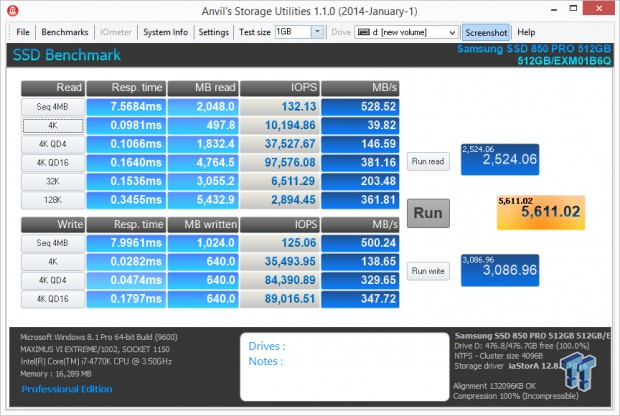
The performance with compressible data and incompressible data is the same, so you don't have to worry about performance loss while editing audio and video files.
Low Queue Depth Read IOPS
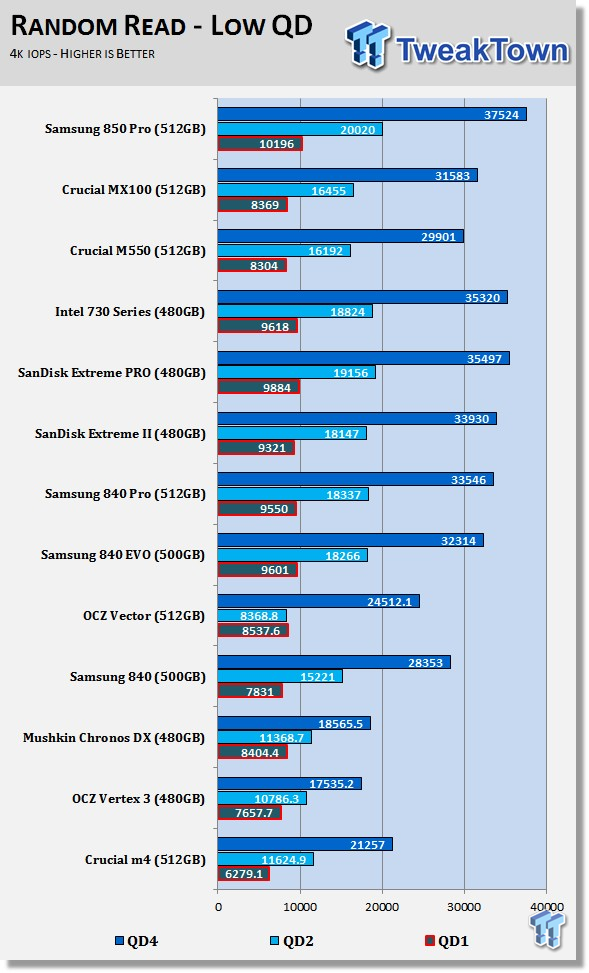
The number of drives on the market that can reach 10,000 4K random read IOPS at QD1 can be counted on one hand. The Samsung 850 Pro 512GB just increased the list by one. Unlike the 840 EVO, the 850 Pro manages to make the magical 10K list without using a SLC write method in the flash translation layer. This drive manages 10K IOPS with the 3D V-NAND MLC.
Here you can also see that the performance scales very well. By QD4 the 850 Pro has walked away from the other drives by a significant margin.
High Queue Depth Read IOPS
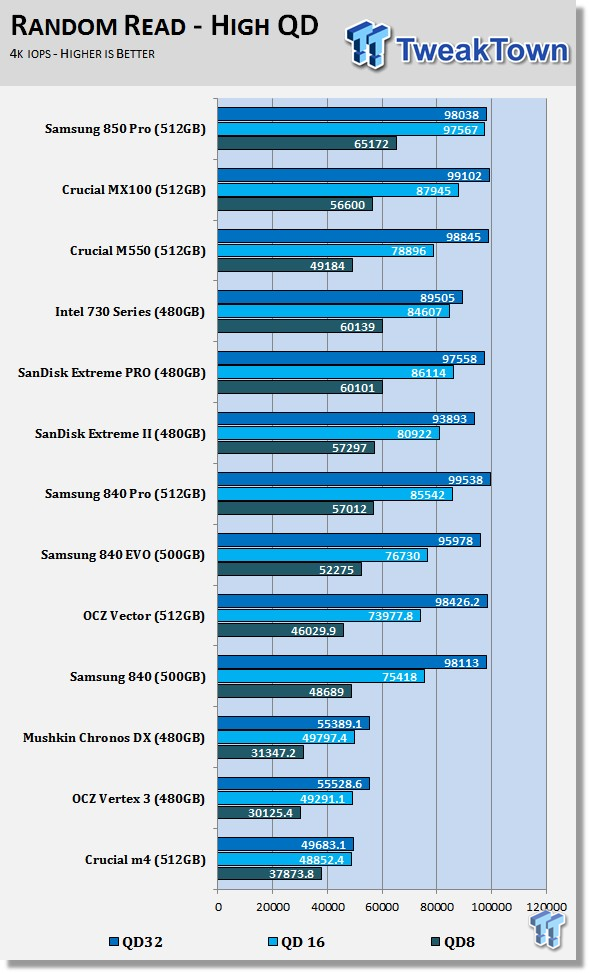
It's difficult to reach high read queue depths in a normal desktop environment. That said, the 850 Pro really gets up and goes as the commands stack up.
Low Queue Depth Write IOPS

Samsung quotes the maximum random write performance at 90K IOPS and the drive nearly gets to that at QD4.
High Queue Depth Write IOPS

By QD8, the 850 Pro 512GB hits 90K write IOPS, and holds that mark all the way to QD32 without dropping back down.
Benchmarks - Mixed Read / Write Workloads
In this series of tests, we measure mixed workload performance. We start with 100% read and then add data writes to the mix until we get to 100% writes, in 10% increments. We believe this will be the next major area SSD manufactures will address after performance consistency.
Sequential Mixed Workload Bandwidth

All SSDs lose performance with a mixed workload. SATA is half-duplex so the drive has to receive all of the commands and use native command queuing to prioritize the requests. Looking at the test through a LeCroy Teledyne Sierra M6 analyzer we can see how the drives tend to work the read load first and then handle the write requests.
The 850 Pro 512GB has some trouble early on when a small amount of write requests are added to the mix, but quickly regains performance as more writes are introduced.
80% Read / 20% Sequential Write Bandwidth

For consumers, the 80% read and 20% write mix is a good place to measure. The 850 Pro isn't the best at this mix, but it's certainly not bad either.
Random Mixed IO 50/50 Workload

The random 50/50 mix is a new test we're introducing in this review. At this time we only have a few new SSDs tested in this capacity size but as we finalized the test we'll go back and retest all of the market leaders.
The Samsung 850 Pro shows a significant lead compared to the other 512GB capacity class drives in the chart. Surprisingly, the 850 Pro even increases performance at QD64 over QD32. This shows the drive is able to effectively execute high command requests.
PCMark 8 Consistency Test
Futuremark PCMark 8 Extended - Consistency Test
Version and / or Patch Used: 2.0.228
Heavy Usage Model:
FutureMark's PCMark 8 allows us to wear the test drive down to a reasonable consumer steady state and then watch the drive recover on its own through garbage collection. To do that, the drive gets pushed down to steady state with random writes and then idle time between a number of tests allows the drive to recover.
Precondition Phase:
1. Write to the drive sequentially through up to the reported capacity with random data.
2. Write the drive through a second time (to take care of overprovisioning).
Degradation Phase:
1. Run writes of random size between 8*512 and 2048*512 bytes on random offsets for 10 minutes.
2. Run performance test (one pass only).
3. Repeat 1 and 2 for 8 times, and on each pass increase the duration of random writes by 5 minutes.
Steady state Phase:
1. Run writes of random size between 8*512 and 2048*512 bytes on random offsets for 50 minutes.
2. Run performance test (one pass only).
3. Repeat 1 and 2 for 5 times.
Recovery Phase:
1. Idle for 5 minutes.
2. Run performance test (one pass only).
3. Repeat 1 and 2 for 5 times.
Storage Bandwidth
PCMark 8's Consistency test provides a ton of data output that we use to judge a drive's performance. Here we see the three states of performance for the select SSDs, light use, consumer steady state and worst case.

We were surprised the 850 Pro 512GB didn't put on a better show in our PCM8 Consistency Test. With RAPID Mode, the 850 Pro does a little better, but with the drive on its own, the results are not as high as we expected. That doesn't mean the 850 Pro 512GB didn't do well, the drive turned in a solid performance result, but it doesn't do as well as the Extreme PRO in a heavy use situation.
Storage Bandwidth All Tests

Here we see all of the tests from the workload. The 850 Pro 512GB shows more performance drop off after extremely heavy use than we expected.
PCMark 8 Consistency Test - Continued
Total Access Time
The access time test measures the total latency across all 18 tests. This is one of, if not the most important test we run at this time for consumer SSDs. When your latency is low your computer feels fast, it's just that simple.
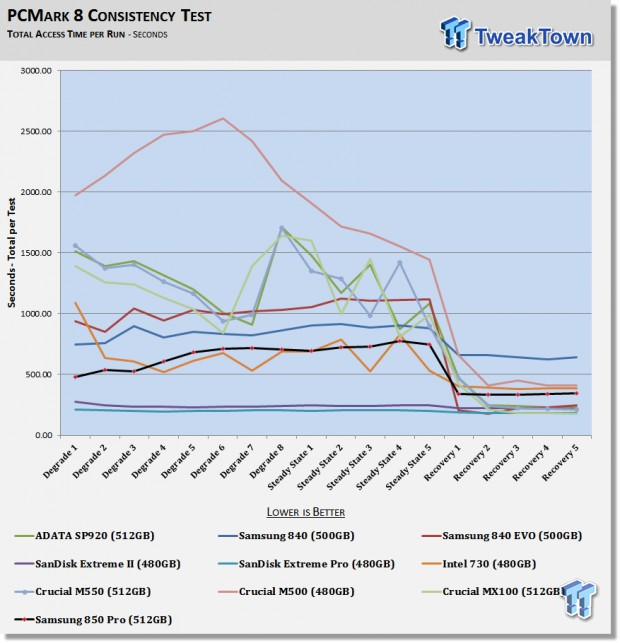
Here we see the latency tests through the different stages of wear on the drives. The 850 Pro 512GB does reasonable well here, but with just the drive, the latency is higher than the Extreme PRO.
Disk Busy Time
In the final test, we measure the amount of time the drive worked to read and write the data to complete the test. When a drive is active, it uses more power so the faster it can complete the tasks the faster it can fall into a low power state.
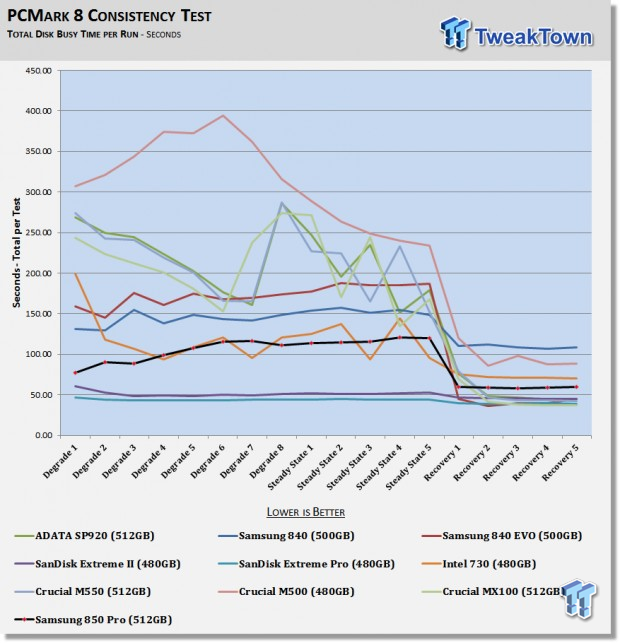
The 850 Pro disk busy time is nearly identical to the access time chart.
Benchmarks - Power Testing
Bapco MobileMark 2012 1.5
Version and / or Patch Used: 2012 1.5
Developer Homepage: http://www.bapco.com
Test Homepage: http://www.bapco.com
MobileMark 2012 1.5 is an application-based benchmark that reflects usage patterns of business users in the areas of office productivity, media creation and media consumption. Unlike benchmarks that only measure battery life, MobileMark 2012 measures battery life and performance simultaneously, showing how well a system design addresses the inherent tradeoffs between performance and power management.

We've added more drives to our new notebook battery life test with the Lenovo T440 that supports DEVSLP. One of the drives we added over the last week is the Seagate Momentus Thin, a low power 500GB mechanical disk drive that ships in a number of notebook and Ultrabooks on the market today. As you can see, not all SSDs deliver longer battery life over HDDs.
The Samsung 850 Pro does significantly better than our Momentus Thin baseline. The 850 Pro is impressive in this test, because not only is the drive very fast, it's also efficient.
Power Limited Performance
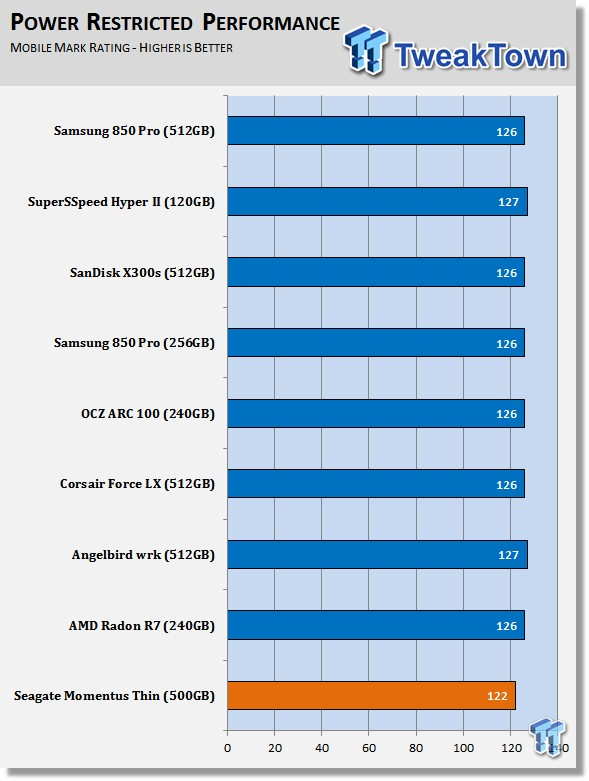
The MobileMark performance rating is very sensitive, each number is a significant increase in performance when the power clamps are in place.
Final Thoughts

We didn't spend a lot of time talking about the 3D V-NAND in this article or RAPID Mode. We just published a very detailed V-NAND whitepaper and RAPID Mode was discussed in detail in our initial reviews.
The 850 Pro is a complicated product made easy by its performance. When a drive is as fast as the Samsung 850 Pro, we don't have to go into a lot of detail about the technology. The 850 Pro 512GB is one of the fastest SSDs in this capacity size, it offers the best warranty and flash endurance.
The 3D V-NAND technology is cool, but do we really care about the compound structure of the tires of a new Ferrari? Not really, we just know it's fast and fun, and that's what really counts. The 850 Pro check all of the boxes for security, AES 256-bit for TCG Opal 2.0 and eDrive, it has RAPID Mode for DRAM caching of the data, and offers a guaranteed 150TB of write endurance. The facts just all line up, and the end product is impressive.
I think of all the capacity sizes Samsung offers the 850 Pro in, the 512GB size is the sweet spot for performance, capacity and cost. At $399.99 at the time of writing, the 512GB model costs a bit more than the value centric SSDs on the market in the same size, but delivers enough value to warrant paying the higher price.
For most enthusiasts, this will be the last SATA based SSD you buy for your main system. The 850 Pro will outlast your other components, and then when it's time to upgrade, we'll be several generations deep in M.2 PCIe based technology.
If you are shopping for the best and don't mind spending a bit more to do something that doesn't need replacing for a few years, then the 850 Pro 512GB from Samsung is for you.

